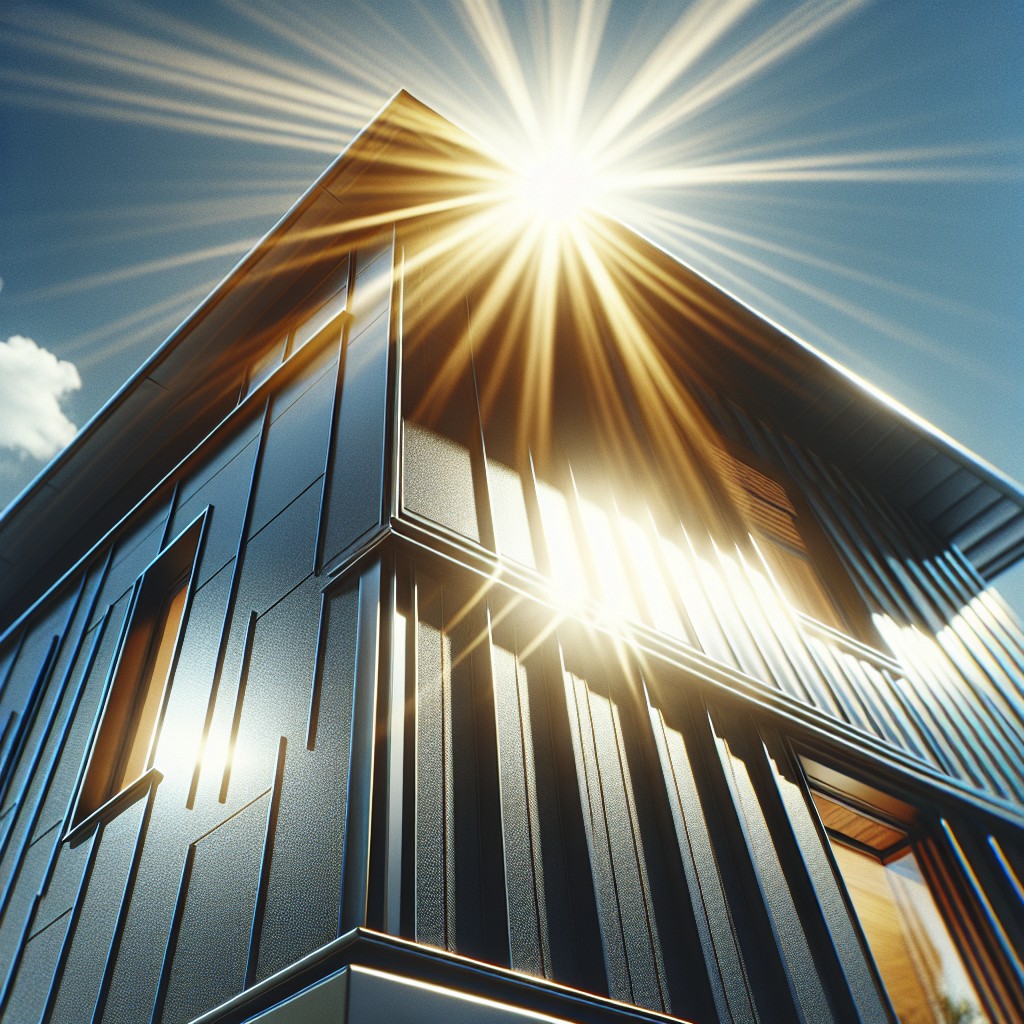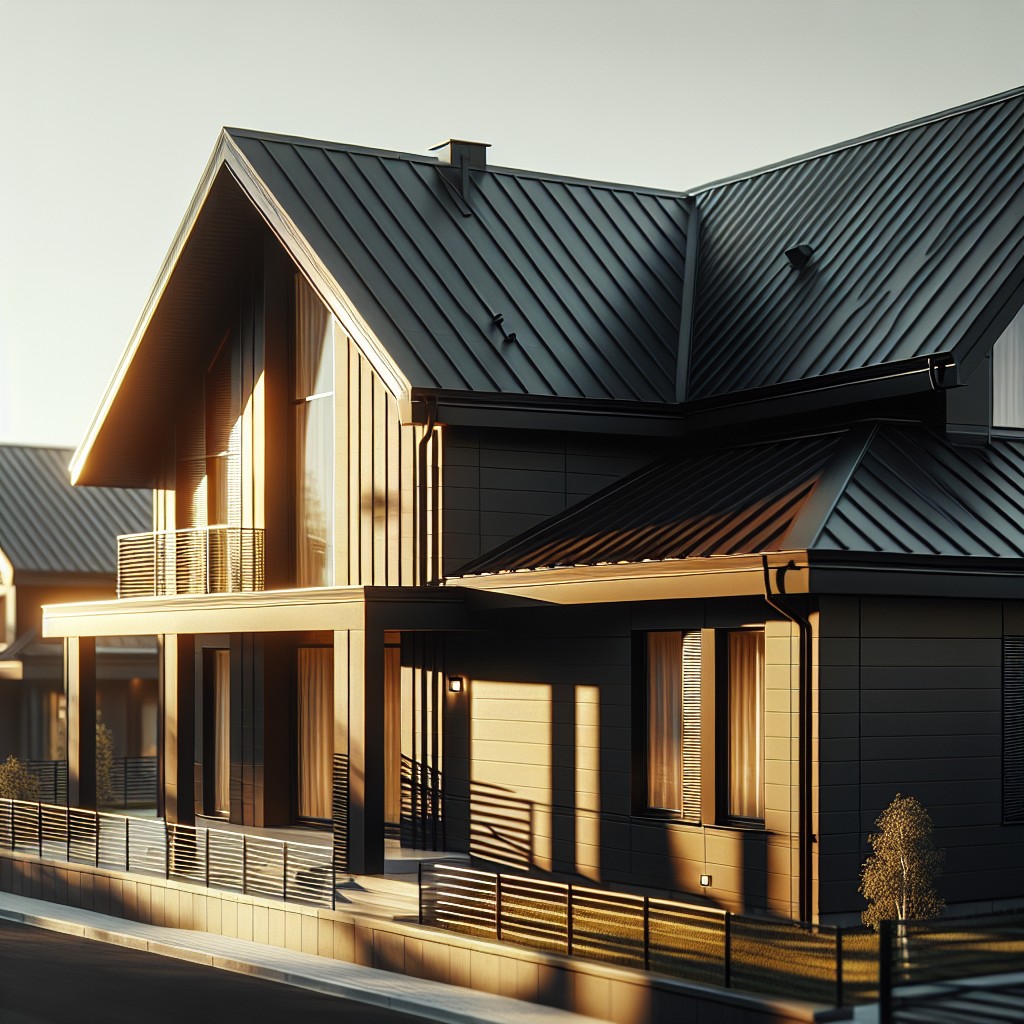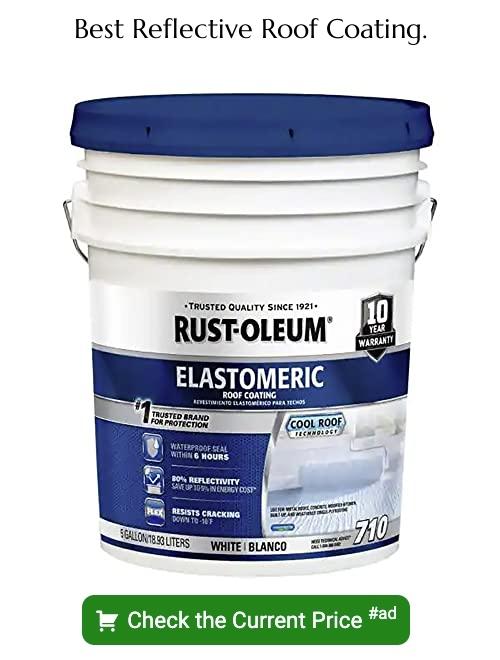Last updated on
A black metal roof can make your house hotter due to its ability to absorb more heat from the sun compared to lighter colors.
Key takeaways:
- Black metal roofs absorb more heat from the sun.
- Advanced reflective technology can mitigate heat absorption.
- Darker colors like black contribute to higher surface temperatures.
- Proper ventilation and insulation are key for temperature regulation.
- Consider the specific climate and balance heat absorption and energy efficiency.
Thermal Characteristics of Black Metal Roofs

Metal is inherently a good conductor of heat, which means that it has the potential to transfer heat efficiently into your home if not properly installed or insulated.
Black, given its propensity to absorb more solar energy than lighter colors, can exacerbate this effect, causing the surface of the roof to heat up considerably under direct sunlight.
However, advancements in metallurgical technologies have allowed for the incorporation of special pigments that enhance the reflective properties of black metal roofing.
This introduces a counteracting force to the natural absorptive qualities of the color, enabling the roof to reflect a significant portion of the solar radiation back into the atmosphere.
Moreover, modern black metal roofs often come with granular coatings that further mitigate heat absorption by increasing the emissivity, which is the material’s ability to release absorbed heat.
Despite the potential for higher heat absorption, a properly installed black metal roof with adequate insulation and ventilation can perform effectively at keeping a home comfortable across a variety of climates.
Black Metal Roof Absorption Vs. Reflectivity

Metal roofs, including black ones, are typically coated with reflective pigments to enhance their ability to reflect sunlight. Despite their dark coloration, which inherently absorbs more heat than lighter shades, modern black metal roofs often incorporate advanced reflective technology. This technology allows them to reflect a significant portion of the solar radiation back into the atmosphere, instead of transferring it into the building.
The science behind this involves two key concepts: solar reflectance and thermal emittance. Solar reflectance is the measure of how much solar energy is reflected by the roof, while thermal emittance refers to the roof’s ability to release absorbed heat.
High solar reflectance reduces the solar gain, keeping the surface cooler, while high thermal emittance allows for rapid cooling of the roof once the sun goes down. When considering a black metal roof, it’s essential to examine the specific product’s solar reflectance and thermal emittance ratings to understand its overall heat management capabilities.
Impact of Color On Roof Surface Temperature
Color plays a significant role in determining the surface temperature of a roof. Darker colors, particularly black, absorb more solar radiation than lighter colors, which contributes to higher surface temperatures.
Here are some key points to understand:
- Solar Absorption: Dark hues like black absorb up to 90% of the radiant energy from the sun, leading to increased heat on the roof’s surface.
- Heat Conduction: The absorbed energy is then conducted into the roofing material, potentially raising the temperature inside the home if proper insulation is not in place.
- Light vs. Dark Shades: In contrast to dark colors, light-colored roofs reflect more sunlight and absorb less heat, staying cooler as a result.
- Thermal Emittance: Black metal roofs can emit some of the absorbed heat by radiating it away, but their efficiency at this depends on the specific material and coating used.
Understanding the interaction between roof color and temperature can inform better roofing decisions and improve a home’s thermal efficiency.
Roof Color and Energy Efficiency
When choosing a roof color for energy efficiency, consider how different hues interact with light. Lighter colors, traditionally, reflect more sunlight and absorb less heat than darker tones. As a result, homes with lighter roofing can remain cooler during the sunniest parts of the day, potentially reducing the need for air conditioning.
In contrast, darker roofs absorb more heat from sunlight, which can make them less energy efficient in hot climates because they can increase the temperature inside the house. However, during cooler months, a dark roof can actually be beneficial as it absorbs heat from the sun and may lower heating costs.
Energy efficiency also ties into the emittance property of the roof material—its ability to release absorbed heat. Metals, including black metal roofs, have a high thermal emittance, which helps mitigate the potential warming effect of their dark color.
Deciding on the ideal roof color for energy efficiency largely rests on balancing these factors with your specific climate and the overall insulation of your home.
Sun Exposure and Effect On Black Metal Roofs
When considering the effect of sun exposure on your roofing, the duration and intensity of sunlight play crucial roles. Metal roofs, including those with black finishes, are designed to endure direct sunlight, but certain factors can influence their heat absorption levels:
1. Angle of Incidence: The angle at which sunlight hits your roof affects how much heat is absorbed. Lower angles, typical of early morning and late afternoon, may result in less heat absorption compared to when the sun is directly overhead.
2. Duration of Exposure: With a full day’s exposure to the sun, a black metal roof can reach higher temperatures than it would in areas that experience shorter periods of sunlight.
3. Geographic Location: Homes in regions closer to the equator will have more intense solar radiation, potentially increasing the temperature of a black metal roof more significantly than in less sun-intensive climates.
4. Seasonal Variations: During the summer, when the sun’s rays are most direct, black metal roofs are likely to absorb more heat compared to cooler seasons.
Understanding these aspects can inform decisions about appropriate roofing materials and energy-efficient designs tailored to your home’s geographic and architectural specifics.
Ventilation and Its Role in a Black Metal Roof’s Heat Management
Effective ventilation plays a critical role in mitigating the heat retention of a black metal roof. Here’s how it contributes to temperature regulation:
1. Ridge and Soffit Vents: This combination allows for continuous airflow along the underside of the roof, carrying away excess heat that the black metal surface has absorbed.
2. Gable Vents: Positioned on the exterior wall, near the roof peak, these vents help by expelling hot air as it rises and drawing in cooler air from outside.
3. Powered Attic Vents: These utilize fans to force hot air out of the attic space, which can be especially beneficial on days with little wind.
The key is to maintain a balance between air intake (at the soffits) and air exhaust (at the ridge or gables), to ensure that hot air doesn’t accumulate under the roof. This balance helps maintain a cooler roof structure and indirectly improves the indoor comfort of the home.
Insulation Strategies for Homes With Black Metal Roofs
Proper insulation serves as a critical barrier between the heat conducted by a black metal roof and the interior of a home. High-quality insulation can significantly reduce heat transfer, contributing to a cooler living environment and improved energy efficiency.
There are several insulation options that homeowners can consider:
- Spray Foam Insulation: This is applied directly to the underside of the metal roof within the attic space, creating a tight seal that helps prevent heat from penetrating the living areas below.
- Radiant Barriers: These work by reflecting radiant heat away from the home. When installed beneath a black metal roof, the barrier can help maintain lower attic temperatures.
- Fiberglass or Cellulose Batts: Positioned between the attic floor joists, these traditional forms of insulation can be effective, but they must be installed correctly and without gaps to achieve the best results.
- Rigid Foam Boards: Offering high insulating values, rigid foam can be applied to attic walls and rooflines to help keep the heat at bay.
- Adequate Attic Ventilation: While not insulation per se, ensuring proper airflow in the attic can help expel hot air and reduce the warming effect on the living spaces below.
Selecting the right insulation involves considering the specific characteristics of the home, the local climate, and balancing the initial investment against long-term energy savings.
Black Metal Roofs and Infrared Reflective Pigments
Infrared reflective pigments in black metal roofing materials offer a technological advancement that mitigates heat absorption. Here are some key points explaining how these pigments influence the roof’s thermal performance:
- Reflective Technology: These pigments are designed to reflect infrared radiation, which is a significant component of the sun’s spectrum that contributes to heat buildup.
- Surface Temperature Reduction: By reflecting infrared light, the roof stays cooler, which can lead to lower surface temperatures compared to traditional black metal roofs.
- Energy Efficiency Enhancement: Homes with metals roofs containing these pigments may experience reduced cooling demands, leading to savings on energy bills.
- Color Retention: Despite the reflective qualities, the roof maintains a rich black color and does not compromise on aesthetics.
- Environmental Impact: By improving a home’s energy efficiency, these innovative pigments also contribute to lower greenhouse gas emissions.
Selecting black metal roofing with infrared reflective pigments can be a smart choice for those looking for the bold aesthetic of a black roof without the added heat.
Black Metal Roofs: Comparison With Other Roofing Materials
Comparing black metal roofs with other materials highlights their unique features and potential benefits:
- Asphalt Shingles: Generally lighter in color and less heat-absorbent than black metal, asphalt shingles may result in a cooler attic space, although they typically have a shorter lifespan.
- Clay Tiles: Known for their reflective properties, especially if light-colored, clay tiles can keep a house cooler than black metal roofs but are often heavier and may require additional structural support.
- Slate Roofs: Slate’s natural color variations provide moderate reflective properties, but it’s a heavy material similar to clay and often more expensive than metal roofing.
- White or Light Metal Roofs: These reflect more sunlight than black metal roofs, potentially keeping a building cooler and reducing cooling costs.
Each material has its distinct thermal and physical properties, influencing both home temperature and overall energy efficiency.
FAQ
Is a black metal roof a bad idea?
While a black metal roof may absorb more heat in the summer, the use of adequate insulation can effectively counter this heat transfer, making it an acceptable choice for homeowners.
What color metal roof is best for hot climate?
The best color for a metal roof in a hot climate is cool tones such as blue, green, or gray due to their superior solar reflectance and thermal emittance properties, ensuring efficient energy conservation.
Is black a good Colour for a metal roof?
While a black metal roof can aesthetically enhance your home, it is also potentially going to increase the temperature inside your home, particularly during summertime.
Do black roofs absorb more heat?
Yes, black roofs absorb more heat compared to lighter-colored roofs, but advancements in the roofing industry have enhanced the energy efficiency of black shingles.
Does a black metal roof impact energy efficiency?
Yes, a black metal roof can indeed impact energy efficiency as it tends to absorb more heat, potentially increasing cooling costs during warmer seasons.
How does a black metal roof perform compared to lighter colored options?
Black metal roofs tend to absorb more heat than lighter colored options, which may increase cooling costs during warmer months.
What are the temperature differences between black and other colored metal roofs?
Black metal roofs absorb more heat and are typically warmer than other colored metal roofs.





